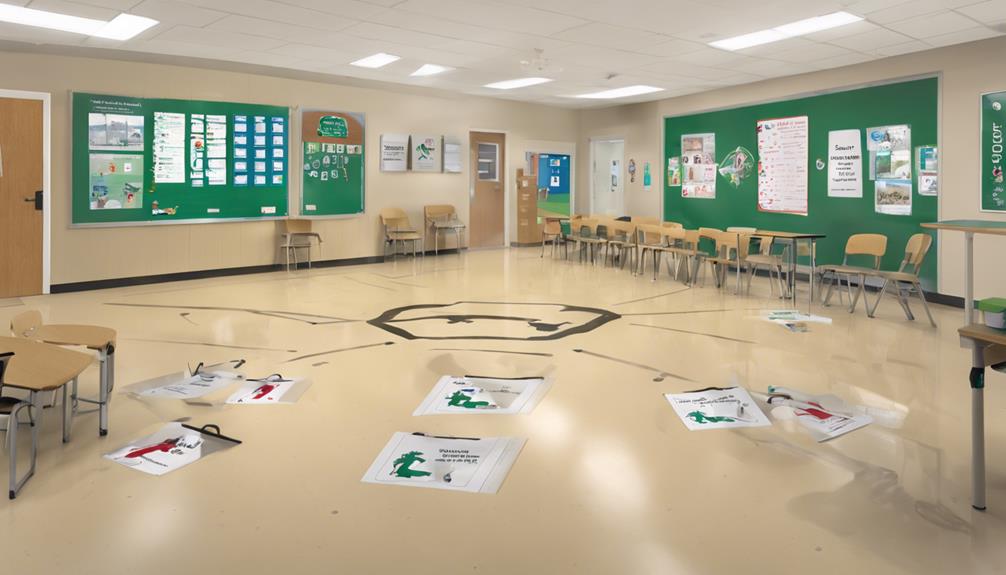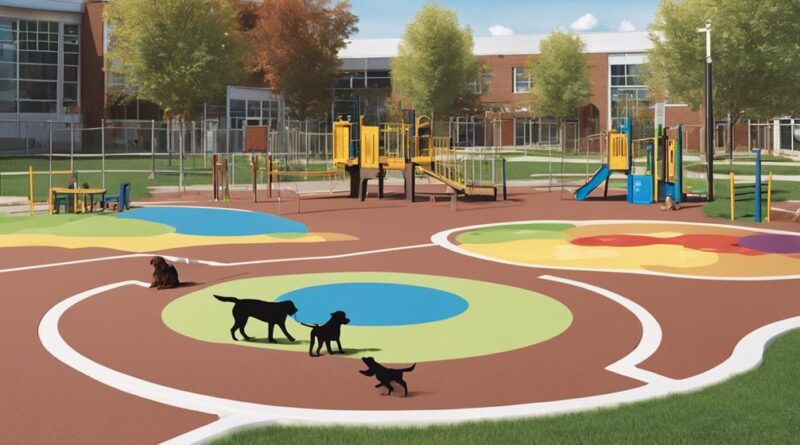9 Best Laws for Dogs Within School Premises
Are you aware of the potential benefits and challenges that come with allowing dogs on school grounds?
Imagine a scenario where guidelines are in place to ensure a harmonious coexistence between furry friends and students.
From leash requirements to emergency protocols, these laws not only prioritize safety and cleanliness but also foster a positive environment for both humans and canines.
How can these regulations shape the school experience for all stakeholders involved?
School Policies on Dog Entry
Are dogs allowed on school premises during school hours? School policies regarding dogs on campus can vary, but generally, dogs aren't permitted unless they're service animals. This restriction is in place to ensure the safety and well-being of all students and staff, especially those with dog allergies. However, accommodations can be made for service animals to allow them on school premises.
Service animals are an exception to the 'no dogs' rule because they're specially trained to assist individuals with disabilities. These animals undergo rigorous training to behave appropriately in public settings, including schools. While other dogs may pose a risk of triggering allergies or causing disruptions, service animals are well-behaved and essential for their owners' daily functioning.
If there are concerns about dog allergies among students or staff, the school may need to make accommodations to ensure everyone's health and safety. This could involve implementing cleaning protocols, restricting the areas where the dog is allowed, or providing alternative arrangements for affected individuals.
Leash and Restraint Requirements
Ensuring all dogs on school premises are properly leashed and restrained is crucial for maintaining a safe environment for students and staff. Proper leash and restraint requirements help prevent accidents and ensure that dogs remain under control at all times.
Here's what you need to know:
- Leash Requirements: All dogs brought onto school premises must be on a leash that's sturdy and no longer than six feet. This helps in controlling the dog's movements and prevents them from running freely around the school grounds.
- Restraint Guidelines: In addition to leashes, dogs should also be equipped with appropriate restraints such as harnesses or gentle leaders if necessary. These restraints aid in better controlling the dog's behavior and ensuring the safety of everyone present.
- Consideration of Off-Leash Areas: Some schools may have designated off-leash areas for dogs to play and exercise. However, even in these areas, dogs should be well-trained and under the supervision of their owners. Participating in training programs can help owners better manage their dogs in off-leash environments, promoting a safer and more enjoyable experience for all.
Vaccination and Health Certificates
Maintaining up-to-date vaccination records and health certificates for dogs on school premises is essential for safeguarding the well-being of all individuals within the community. Ensuring that all dogs have received proper vet approval for vaccinations is crucial to prevent the spread of diseases and maintain a safe environment.
Proper record-keeping is key in tracking the vaccination status of each dog. By maintaining accurate health certificates, schools can easily verify which dogs are up-to-date with their vaccinations, reducing the risk of outbreaks and ensuring the safety of students, staff, and visitors. Vet approval adds an extra layer of assurance that the vaccinations are administered correctly and are in line with health standards.
Regularly updating these records is imperative to guarantee that all dogs remain compliant with vaccination requirements. Schools should establish a system for checking and renewing health certificates to prevent any lapses in vaccination coverage. By prioritizing vet approval and meticulous record-keeping, schools can create a secure environment where dogs can coexist safely with the school community.
Designated Dog-Friendly Areas
Designated dog-friendly areas provide safe spaces within school premises for dogs to interact and play, fostering a harmonious environment for both canine companions and the school community. These areas are essential for promoting dog socialization and ensuring that the dogs can engage in healthy outdoor activities while on school grounds.
- Encouraging Interaction: Designated dog-friendly areas encourage dogs to interact with each other, helping them develop social skills and build positive relationships with other animals.
- Physical Exercise: These outdoor play areas allow dogs to engage in physical activities such as running, playing fetch, and exploring, promoting their overall health and well-being.
- Stress Reduction: Providing designated areas for dogs to play and socialize can help reduce stress and anxiety in the animals, leading to happier and calmer dogs within the school environment.
Supervision and Behavioral Guidelines
To ensure a safe and conducive environment for all, it's imperative to establish clear supervision and behavioral guidelines for dogs within school premises. Supervision guidelines play a crucial role in maintaining order and safety. All dogs brought onto school grounds must be accompanied by a responsible adult who's capable of controlling the animal at all times. This ensures that any unforeseen situations can be managed promptly and effectively. Additionally, it's essential that the designated dog-friendly areas are clearly marked and that dogs are restricted from entering other parts of the school to prevent disruptions.
Behavioral expectations for dogs within school premises are equally significant. It's expected that all dogs exhibit good behavior and are well-trained to interact positively with students, staff, and other animals. Aggressive behavior, excessive barking, or any form of intimidation won't be tolerated. Dog owners must ensure that their pets are socialized and accustomed to being around people in a school environment. It's recommended that dogs undergo obedience training to follow basic commands and behave appropriately in different situations.
Waste Disposal Regulations
Ensure that all waste generated by dogs within school premises is disposed of properly according to designated regulations to uphold cleanliness and hygiene standards. Proper waste management is crucial to maintain a safe and healthy environment for everyone.
Here are some key points to consider:
- Separate Waste Bins: Place separate bins for dog waste to ensure proper disposal and prevent mixing with other types of waste.
- Regular Cleaning Schedule: Implement a regular cleaning schedule to promptly remove and dispose of dog waste to avoid unpleasant odors and potential health hazards.
- Educational Campaigns: Engage with the school community through educational campaigns to raise awareness about the importance of waste disposal, its environmental impact, and the role each individual plays in maintaining cleanliness standards.
Emergency Protocol for Dog Incidents

In case of dog incidents within school premises, promptly alert designated staff members to ensure swift and appropriate response. Having staff members trained in first aid is crucial for providing immediate assistance in case of dog-related emergencies. This training equips them to handle situations like dog bites or injuries until professional medical help arrives. It's vital to have clear communication strategies in place to inform all staff members about the incident, ensuring a coordinated response.
First aid training should cover basic wound care, CPR for dogs if applicable, and how to handle a frightened or injured animal safely. Additionally, staff should be educated on recognizing signs of distress or aggression in dogs to prevent escalation of incidents. Regular drills and updates on first aid procedures can help keep staff prepared for any unforeseen circumstances involving dogs on school premises.
Communication strategies play a pivotal role in managing dog incidents efficiently. Designated communication channels should be established to promptly inform relevant staff members about the situation. This could include using walkie-talkies, intercom systems, or designated phone numbers for emergencies. Ensuring that everyone is on the same page regarding protocols and procedures will help maintain a safe environment for students, staff, and any dogs present on school grounds.
Communication With Dog Owners
Effective communication with dog owners is key to fostering a safe and cooperative environment within school premises. When it comes to managing dogs on school grounds, clear and consistent communication plays a vital role in ensuring the well-being of all individuals involved. Here are some essential points to consider:
- Owner education: Providing dog owners with information about school policies, rules, and expectations regarding dogs on campus is crucial. Educating owners about the importance of following these guidelines can help prevent misunderstandings and promote a harmonious relationship between the school community and dog owners.
- Behavior training: Encouraging dog owners to invest in behavior training for their pets can significantly contribute to a safer environment within school premises. Well-trained dogs are more likely to exhibit good behavior, reducing the risk of incidents or disruptions on campus. Additionally, behavior training can enhance the bond between dogs and their owners, fostering a sense of responsibility and accountability.
- Open communication channels: Establishing open lines of communication with dog owners allows for timely exchange of information and feedback. School authorities should encourage dog owners to raise any concerns or issues they may have regarding their pets or the school environment. This two-way communication promotes transparency and collaboration, ultimately benefiting the entire school community.
Frequently Asked Questions
Can Students Bring Their Own Dogs to School Events or Activities Outside of Regular School Hours?
You're responsible for following school policies regarding bringing dogs to events outside regular hours. Ensure that the school allows pets during these activities, and if so, make sure your dog is well-behaved and leashed.
Be mindful of others' comfort and safety around animals. Always clean up after your pet and supervise them at all times. Remember, it's essential to respect the rules and consider everyone's well-being.
Are There Any Restrictions on the Size or Breed of Dogs Allowed on School Premises?
When bringing dogs to school, it's important to check for size restrictions and breed limitations. These rules are in place to ensure safety for everyone on the premises.
Before deciding to bring your furry friend, make sure they comply with the school's regulations. It's essential to respect these guidelines to create a harmonious environment for all.
Are There Any Designated Areas Where Dogs Are Not Allowed Even if They Are Normally Allowed on School Grounds?
In school, you'll find some areas where dogs aren't allowed, even if they can roam on the grounds. These spaces, known as dog-free zones, are set by school policies to ensure safety and cleanliness.
Remember to respect these rules and keep your furry friend in the permitted areas. Follow the guidelines to maintain a harmonious environment for everyone at the school.
Are There Any Specific Rules Regarding Service Dogs Versus Pets on School Premises?
When it comes to service dog accommodations and pet policies on school premises, it's important to differentiate between them. Service dogs are generally allowed to accompany individuals with disabilities in all areas of the school, while pets may have restrictions.
Emotional support animals and therapy dogs might fall under different guidelines, so it's essential to check the specific rules regarding these categories. Make sure to adhere to the school's policies to ensure a smooth experience for everyone.
How Are Incidents Involving Aggressive Behavior or Biting by a Dog Handled by the School Administration?
When incidents involving aggressive behavior or biting by a dog occur on school premises, the administration handles them swiftly. They may have training programs in place for dog owners, and if necessary, disciplinary actions are taken.
Liability issues and insurance coverage are also carefully considered to protect all parties involved. It's crucial to address these situations promptly and effectively to ensure the safety and well-being of everyone on campus.
Conclusion
Overall, these 9 laws for dogs within school premises are essential for creating a safe and welcoming environment for both students and their furry friends.
By implementing these regulations, schools can ensure that dogs are well-behaved, properly cared for, and that any potential incidents are handled efficiently.
With clear guidelines in place, everyone can enjoy the benefits of having dogs on campus while minimizing any potential risks or disruptions.
